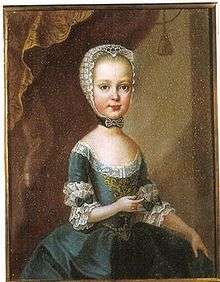Archduchess Maria Theresa of Austria (1762–1770)
Archduchess Maria Theresa of Austria (German: Maria Theresia Elisabeth Philippine Luise Josepha Johanna, English: Maria Theresa Elisabeth Philippine Louise Josepha Joan; 20 March 1762 – 23 January 1770) was a daughter of Joseph II, Holy Roman Emperor, and his first wife, Isabella of Parma.
| Maria Theresa | |||||
|---|---|---|---|---|---|
 | |||||
| Born | 20 March 1762 Schönbrunn Palace, Vienna | ||||
| Died | 23 January 1770 (aged 7) Schönbrunn Palace, Vienna | ||||
| |||||
| House | Habsburg-Lorraine | ||||
| Father | Joseph II, Holy Roman Emperor | ||||
| Mother | Princess Isabella of Parma | ||||
Life

Maria Theresa's parents, Crown Prince Joseph (future Holy Roman Emperor) and Princess Isabella of Parma were married in Vienna on 16 October 1760. In late 1761, Isabella became pregnant and on 20 March 1762, she delivered a daughter who was christened Maria Theresia Elisabeth Philippine Louise Josephe Johanna[1] and was styled Archduchess of Austria. On her maternal side, little Maria Theresa descended from people such as the first Bourbon King of Spain, Philip V of Spain. On her paternal side, she descended from the famous Maria Theresa and her husband, Francis I, Holy Roman Emperor. Her ancestors could be traced to as far as Charles I Magnus, a ninth-century Holy Roman Emperor. When the little archduchess was a little over a year old, her mother died a week after giving birth to Archduchess Marie Christine, who died a few moments after being born. Her father was inconsolable and found refuge in his infant daughter, whom he referred to as his "second self". Maria Theresa was also close to her youngest paternal aunt, Archduchess Maria Antonia, just seven years her senior.[2] She was Maria Theresa's first grandchild.
Death
Just a few months short of her eighth birthday, Archduchess Maria Theresa became ill with pleurisy. Her father, by that time Holy Roman Emperor, did everything in his power to save her and attended her bedside even at night. However, the medicine in those days was highly undeveloped and Archduchess Maria Theresa died on 23 January 1770 from a very high fever.[3] Her father was heartbroken. When Khevenhüller had to disturb Joseph in order to make the arrangements for the funeral, the emperor, with tears in his eyes, told him *he had lost, so to speak, his only consolation and pleasure'.
Below are excerpts from a letter from Joseph to his daughter's governess, the marquise d'Herzelles, written a few hours after the child's death;
If decency permitted, it would be with you alone that I would be pouring out the sorrow which... pierces my soul. I have ceased to be a father: it is more than I can bear. Despite being resigned to it, I cannot stop myself thinking and saying every moment: 'O my God, restore to me my daughter, restore her to me.' I hear her voice, I see her. I was dazed when the terrible blow fell. Only after I had got back to my room did I feel the full horror of it, and I shall go on feeling it all the rest of my life since I shall miss her in everything...
As my daughter's sole heir, I have just given orders... that I should keep only her diamonds. [You are to have everything else.] One thing that I would ask you to let me have is her white dimity dressing-gown, embroidered with flowers, and some of her writings...
The death of his only and much-idolized daughter confirmed Joseph in his growing misanthropy and finished the job of making him a compulsive worker.
The little Archduchess was the second of Maria Theresa's grandchildren to die, after her younger sister. It is said that, even after her death, her father kept her dresses and shoes.[4] She was buried in the Imperial Crypt, in Vienna. Her tomb consists of a effigy that represents the young Archduchess sleeping on a bed, covered by a blanket, with her hands towards the sky in sign of prayer and surrounded by the Holy Crown of Hungary and the crown of the Holy Roman Emperor.
Ancestors
| Ancestors of Archduchess Maria Theresa of Austria (1762–1770)[5] | |||||||||||||||||||||||||||||||||||||||||||||||||||||||||||||||||||||||||||||||||||||||||||||||||||||||||||||||||||||||||||||||||||||||||||||||||||||||||||||||||||||||||||||||||||||||||||||||||||||||||||||||||||||||||||||||||||||||||||||||||||||||||||||||||||||||||||||||||||||||||
|---|---|---|---|---|---|---|---|---|---|---|---|---|---|---|---|---|---|---|---|---|---|---|---|---|---|---|---|---|---|---|---|---|---|---|---|---|---|---|---|---|---|---|---|---|---|---|---|---|---|---|---|---|---|---|---|---|---|---|---|---|---|---|---|---|---|---|---|---|---|---|---|---|---|---|---|---|---|---|---|---|---|---|---|---|---|---|---|---|---|---|---|---|---|---|---|---|---|---|---|---|---|---|---|---|---|---|---|---|---|---|---|---|---|---|---|---|---|---|---|---|---|---|---|---|---|---|---|---|---|---|---|---|---|---|---|---|---|---|---|---|---|---|---|---|---|---|---|---|---|---|---|---|---|---|---|---|---|---|---|---|---|---|---|---|---|---|---|---|---|---|---|---|---|---|---|---|---|---|---|---|---|---|---|---|---|---|---|---|---|---|---|---|---|---|---|---|---|---|---|---|---|---|---|---|---|---|---|---|---|---|---|---|---|---|---|---|---|---|---|---|---|---|---|---|---|---|---|---|---|---|---|---|---|---|---|---|---|---|---|---|---|---|---|---|---|---|---|---|---|---|---|---|---|---|---|---|---|---|---|---|---|---|---|---|---|---|---|---|---|---|---|---|---|---|---|---|---|---|---|---|---|
| |||||||||||||||||||||||||||||||||||||||||||||||||||||||||||||||||||||||||||||||||||||||||||||||||||||||||||||||||||||||||||||||||||||||||||||||||||||||||||||||||||||||||||||||||||||||||||||||||||||||||||||||||||||||||||||||||||||||||||||||||||||||||||||||||||||||||||||||||||||||||
References
- Lundy, Darryl (November 7, 2004). "Maria Theresia Erzherzogin von Österreich". thePeerage.com. Retrieved January 2, 2012. cites: Montgomery-Massingberd, Hugh (1977). Burke's Royal Families of the World, Volume 1: Europe & Latin America. London: Burke's Peerage. p. 19.
- Laurén, Ann (March 20, 2009). "18th Cent. Maria Theresa, Archduchess of Austria". ann-lauren.blogspot.com. Retrieved January 2, 2012.
- "Marie-Therese von Habsburg-Lothringen" (in French). Roglo.eu. Retrieved January 2, 2012.
- "Maria Theresia" (in German). Kaisergruft.at. Archived from the original on December 27, 2011. Retrieved January 2, 2012.
- Genealogie ascendante jusqu'au quatrieme degre inclusivement de tous les Rois et Princes de maisons souveraines de l'Europe actuellement vivans [Genealogy up to the fourth degree inclusive of all the Kings and Princes of sovereign houses of Europe currently living] (in French). Bourdeaux: Frederic Guillaume Birnstiel. 1768. p. 2.